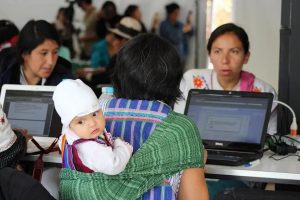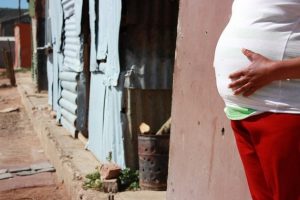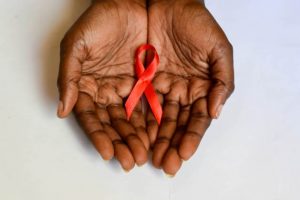
People lay flowers and candles outside the Teplaren LGBTQI
bar in Bratislava, Slovakia, following an attack outside the popular
a meeting place for members of the city’s LGBTQI community in which two
people were killed, and a third seriously injured. Credit: Zuzana Thullnerova/IPS
By Ed Holt
BRATISLAVA, Mar 7 2023 – When D.A.* first heard about the fatal attack on a gay bar in the Slovak capital, Bratislava, last October, their first reaction was a mix of grief, shock and anger.
But then, soon after, the university student and member of the country’s LGBTQI community immediately began to worry.
“I was scared for my own safety,” D.A. told IPS.
Even now, months later, that fear remains in the community.
“I know people who have told me they are afraid to go out at night or who won’t go out on their own and stick together in a group instead. I’m the same,” they said.
The attack on the Teplaren bar, which was carried out by a teenage far-right sympathiser, left two dead and a third, who later recovered, seriously injured. It shocked many and sparked debate about attitudes towards LGBTQI people in the conservative, predominantly Catholic country.
But it also highlighted the threat of extreme violence faced by members of the LGBTQI community not just in Slovakia, but across Europe, coming just months after an attack on a gay bar in Oslo, Norway, which killed two and injured a further 21 people.
And groups working with LGBTQI communities across Europe say that violence is becoming increasingly planned and deadly, leaving many feeling unsafe in countries across Europe.
A report by the European branch of the International Lesbian, Gay, Bisexual, Trans and Intersex Association (ILGA-Europe) released in February showed that 2022 was the most violent year for LGBTQI people across the region in the past decade, both through planned, ferocious attacks and through suicides.
It said this violence came in the wake of rising and widespread hate speech from politicians, religious leaders, right-wing organisations and media pundits.
“We have noticed a rise in hate speech for some time now and have been flagging it up for a number of years. But what we have been surprised by is the sheer ferocity and violence of the hate, and the physical attacks against LGBTQI people,” Katrin Hugendubel, Advocacy Director at ILGA, told IPS.
ILGA’s report shows that problems with hate speech – be it online, or publicly from politicians, state representatives, or religious leaders – against LGBTQI people run right across the continent from Armenia and Austria to Serbia, Sweden, Turkey, and Ukraine, with dire consequences for people and communities “not only in countries where hate speech is rife, but also in countries where it is widely believed that LGBTI people are progressively accepted”.
ILGA’s report highlighted hate speech used during debates on transgender laws in Finland’s parliament, while previously Finnish prosecutors have voiced concerns about hate speech fuelling anti-LGBTQI sentiment in society.
And in Slovakia, politicians, including former prime ministers, have publicly denigrated LGBTQI people, talked of homosexuality and transgender people as “perversions” and, in some cases, even called for legislation to limit LGBTQI people’s rights.
D.A., who said they had friends who had been attacked because of their identity, believes this kind of rhetoric, from politicians or anyone else, helps fuel violence against the LGBTQI community.
“People in Slovakia are often and easily influenced by the kind of information they receive on a daily basis. So yes, hateful rhetoric leads to violence,” they said.
In some other countries, politicians have taken things even further, enacting legislation which effectively prevents any positive public portrayal of the LGBTI community.
At the end of last year, a new law banning LGBTQI ‘propaganda’ was passed in Russia banning any promotion of what authorities see as “non-traditional sexual relations”.
Groups working with Russia’s LGBTQI community said the new law – an extension of 2013 legislation banning the positive portrayal of same-sex relationships to minors – was the latest part of a state system designed to further stigmatise the minority and was brought in amid intensifying anti-LGBTQI political rhetoric.
Violence against the community has been on the rise in Russia over the last decade, and they worry the new law will only fuel it further.
In Hungary, a similar law was passed in 2021, and experts there say it has emboldened people to express their hatred of the LGBTQI community physically.
“According to statements made by the perpetrators of hate incidents (and from looking at social media) it seems that the law reaffirmed already existing homophobic and transphobic prejudices and made it ‘okay’ to act upon them – people are citing that the law is on their side,” Aron Demeter, Programme Director at Amnesty International in Hungary , told IPS.
“Since the law is purposely confusing (and absurd) it is enough that they have an understanding of that it ‘protects children from LGBTI people’ and that serves as a ‘lawful authorisation’ to be hostile,” added.
While such overtly repressive legislation is not common in other countries in Europe, rights activists point out there are gaps in laws in many states protecting the community.
“In quite a lot of countries, there is still a lack of legislation dealing with hate speech specifically against the LGBTQI community,” Hugendubel pointed out.
She added that this should be addressed, but that it was crucial that people at the highest political levels must speak out against anti-LGBTQI hate.
“We feel that we need to see much more from EU institutions and national leaders in a real effort to stop the hate. There need to be clear statements from them saying that hate is not acceptable,” she said.
Immediately after the attacks in Norway and Slovakia, many politicians, both domestic and in other states, were quick to condemn it and the hatred behind it.
But worries remain that LGBTQI people will continue to be used as a welcome source of polarisation by politicians.
“It is important to see how politicians are using LGBTQI as a polarising tool. It’s something they can use to motivate a specific conservative voter base, and it is a tool with works to a certain extent. It is also being used to distract from other issues, such as corruption – it is polarisation at the expense of the LGBTQI community,” said Hugendubel.
However, while hate speech, and the violence it drives – prior to the killings in Norway, there was a massive rise in anti-LGBTQI hate crimes, jumping from 97 in 2020 to 240 in 2021, according to ILGA – is on the rise in Europe, action is being taken against it with growing numbers of prosecutions for hate speech and crimes in many countries.
Progress is also being made on legislative protections for LGBTQI people.
Meanwhile, despite an intensifying instrumentalization of LGBTQI issues by politicians and others against the community, there is a growing acceptance and support for the community in societies, notably in countries where governments are pursuing strongly anti-LGBTQI policies, such as Poland and Hungary, according to the group.
More needs to be done though, said Hugendubel.
“We are calling on all political leaders to step-up, speak out, and be proactive in fighting hate speech, rather than being reactive when faced with its consequences,” she said.
Note: *D.A.’s name has been withheld for reasons of personal safety.
IPS UN Bureau Report







